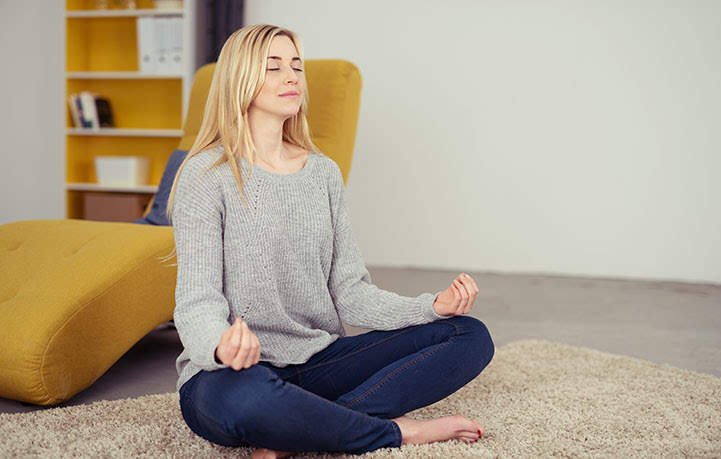
Meditation
Discover effective meditation techniques to improve your sleep quality and enhance your restful nights. Read the article to transform your bedtime routine.
A surprising fact: nearly one-third of adults struggle with chronic insomnia or persistent difficulties in falling or staying asleep. This leaves countless people lying awake, staring at their ceilings night after night.
Our body’s stress response makes falling and staying asleep a real challenge. Meditation techniques for sleep provide a natural solution to this widespread issue. Research shows that regular meditation reduces the size of the amygdala, the stress-response hub of our brain. This reduction explains why bedtime meditation helps ease insomnia and sleep troubles by creating overall calmness.
In this piece, we’ll explore proven breathing techniques for sleep that tap into your body’s natural relaxation response. Mindfulness meditation and yoga nidra are just two methods that can transform your bedtime routine and help you get the restful sleep you deserve.
The quality sleep you’ve been dreaming of is within reach. Let’s take a closer look at these life-changing techniques together.

The connection between meditation and quality sleep goes beyond just feeling relaxed. Your brain works differently during stress and meditation, and this relationship helps explain why meditation can improve your sleep.
Nighttime anxiety makes it hard to fall and stay asleep. Research shows that all but one of three adults has lost sleep due to stress in the last month. Your body responds to late-night worrying in ways that fight against good sleep.
Your sympathetic nervous system kicks into high gear when you’re stressed, releasing cortisol and adrenaline to keep you alert. These “fight or flight” hormones make it almost impossible to fall asleep. The Sleep Foundation points out that stress can:
This creates a vicious cycle. Bad sleep makes you more stressed, and more stress leads to worse sleep. Many people lie awake with their minds racing about work, family, or money right when they need rest the most.
Your brain activity changes in amazing ways when you meditate. Beta waves linked to stress give way to calmer alpha and theta waves that help you relax and feel drowsy. This change matches what happens as you start falling asleep, helping your brain learn to switch into sleep mode more naturally.
Brain scans reveal meditation turns on areas that control attention, like the dorsal lateral prefrontal cortex (DLPFC) and anterior cingulate cortex (ACC). The default mode network that fuels worried thoughts about the past and future becomes quieter.
People who meditate regularly develop these helpful brain patterns more easily. Studies show experienced meditators have more gray matter in brain regions tied to attention and processing sensory information. This might explain why they handle stress better over time.
Harvard researcher Dr. Benson discovered what he called the “relaxation response” – the opposite of how your body reacts to stress. This state:
These physical changes set the stage perfectly to help you fall asleep. Meditation techniques also teach you to watch anxious thoughts without getting caught up in them.
Mindfulness helps stop the endless loop of thoughts that often keeps you awake. You learn to focus on the present moment instead of getting stuck in worry. Studies show mindfulness can cut nighttime anxiety in half while improving your sleep substantially.

Mindfulness meditation is one of the most available techniques that helps people who struggle with sleep issues. The beauty of mindfulness lies in its simplicity – you stay fully present and aware without judgment. Many people battling insomnia or restless nights have found this approach works remarkably well.
✅ Want to try guided mindfulness meditation? Explore sleep-focused sessions on the Art of Living Journey App.
Your breathing and body sensations form the foundation of mindfulness meditation. Here’s how you can start this practice:
This process kicks in your parasympathetic nervous system and fights against the “fight or flight” response that keeps you awake. Your body responds to mindfulness meditation by relaxing, which lowers your heart rate and guides you toward sleep.
The biggest challenge you face when trying to fall asleep is a racing mind. Mindfulness gives you a practical way to handle persistent thoughts:
Thoughts will pop up – that’s natural. Watch them like clouds floating across the sky – they’re there but won’t stay forever. Your job is to notice when your mind wanders and gently bring your attention back to your breathing or body sensations.
This approach is different from forcing yourself to sleep. The harder you try to make yourself sleep, the more it slips away. Non-judgmental awareness creates mental space that lets sleep come naturally.
The right timing makes mindfulness more effective. You have two good options:
Evening sessions around 6 PM create a buffer between work and personal time. This helps you shake off the day’s stress. But practicing right before bed gives you the best sleep benefits.
New to mindfulness meditation? Start with 5-10 minutes each night. A regular practice matters more than how long you meditate. Your brain learns that it’s time to wind down when you stick to a routine. Regular practice helps your mind become skilled at spotting and releasing thoughts that disturb sleep, making it easier to drift off each night.
People new to meditation or those with restless minds will find guided meditation a perfect starting point into sleep-enhancing practices. This approach provides structure and support through an experienced guide’s voice, unlike self-directed techniques.
Try this Daily Meditation for Positivity.
Someone else guides you step by step through a meditation experience during guided meditation, either in person or through audio recordings. This method helps your focus move away from worrying thoughts toward body sensations, breathing patterns, or peaceful imagery.
Your guide takes you through several components:
These exercises combine to trigger your body’s relaxation response. Regular practice will help you notice improvements in falling asleep and staying asleep.
Quality guided meditations for sleep are easier to find than ever:
The best recordings guide you without needing much conscious effort—you simply follow the narrator’s voice that guides you into deep relaxation.
These suggestions will help you get the most from guided sleep meditation:
Your device’s screen should be dim or off when using sleep meditation tracks on your smartphone. Blue light from screens can interfere with melatonin production and counteract the benefits of your meditation.
Recordings that last 15-20 minutes give you sufficient time to transition into sleep mode. Make yourself comfortable in bed before starting, preferably lying down with pillows supporting you.
Note that guided sleep meditation isn’t about forcing sleep—that creates unwanted pressure. Sleep comes as a pleasant side effect of relaxation. Studies show regular practice improves sleep quality, especially when combined with other healthy sleep habits like consistent bedtimes and a cool, dark sleeping environment.

Body scan meditation helps you disconnect from racing thoughts by focusing your attention on physical sensations throughout your body. This simple technique helps identify and release hidden tension that keeps you from falling asleep.
The body scan uses a systematic approach to awareness:
This practice takes 15-20 minutes to complete, but even shorter sessions help prepare you for sleep.
Body scan meditation releases physical tension through several ways:
Your systematic attention to each body part naturally triggers relaxation in areas where stress builds up unconsciously. This happens because awareness itself can prompt muscles to relax—you might not realize you’re tensing until you focus your attention there.
The practice also activates the parasympathetic (“rest and digest”) nervous system, which counteracts stress responses that keep you alert. Research shows that an eight-week body scan meditation program lowered levels of the stress hormone cortisol.
Your body scan becomes even more powerful when combined with strategic breathing:
The 4-7-8 breathing method works well during the first phase of your body scan—inhale for four counts, hold for seven, exhale for eight. You could also match your body scan with diaphragmatic breathing by slowly inhaling through your nose and letting your abdomen expand instead of your chest.
This combination works because focused breathing anchors any wandering thoughts that might interrupt your practice. The physical relaxation from the body scan paired with the mental quieting from breath awareness creates perfect conditions for falling asleep.

“Yogic sleep” or Yoga Nidra stands out among sleep meditation practices. It’s a step-by-step way to reach a state that sits right between being awake and sleeping. Someone watching might think you’re just sleeping, but your mind stays aware the whole time.
Yoga Nidra is different from regular meditation or normal sleep. We practiced it lying down in Shavasana (corpse pose) instead of sitting up straight. Your body shows signs of deep sleep and produces delta brain waves, but your mind stays conscious throughout.
The sort of thing I love about this practice is how it creates an interesting mix – your body sleeps while your mind stays awake. This lets you relax deeply in a way that regular meditation just can’t match. Your body switches to its rest-and-digest mode and turns off its fight-or-flight response. People say an hour of Yoga Nidra can give you the same benefits as four hours of regular sleep.
A complete Yoga Nidra session follows these steps:
Teachers guide you through each stage in sessions that usually last 30-60 minutes.
Research shows Yoga Nidra really helps with sleep problems. People who practice it fall asleep faster and sleep better. Regular practice helps insomniacs fall asleep more quickly and sleep longer.
Yoga Nidra gets your pineal gland working better, which makes more melatonin – a vital hormone that controls your sleep cycles. Research has found that it works better than traditional meditation at reducing anxiety, which often keeps people awake at night.
Yoga Nidra creates deep rest without actual sleep and is a great way to help people who struggle with traditional sleep methods.

Breathing exercises offer one of the quickest ways to improve your sleep quality without any special equipment or training. These techniques help your nervous system move from alertness to a relaxed state that prepares you for rest.
Dr. Andrew Weil developed the 4-7-8 breathing technique based on ancient yogic practices called pranayama. Your body and mind naturally calm down when you create this specific rhythm:
Your parasympathetic nervous system activates when you repeat this cycle 4-6 times. This reduces anxiety and makes falling asleep easier. Research shows the technique lowers heart rate, blood pressure, and rate-pressure product – creating perfect conditions for sleep.
Belly breathing, also known as diaphragmatic breathing, focuses on deep breaths into your diaphragm instead of shallow chest breaths. Here’s this simple technique:
Your chest should stay mostly still while your abdomen expands and contracts. This practice increases parasympathetic activity that signals your brain to relax and manage anxiety responses.
Box breathing gets its name from picturing a box with four equal sides. People sometimes call it square breathing because each phase of the breath cycle takes the same amount of time:
This balanced pattern reduces stress effectively. It takes your mind off worries through counting and calms your nervous system while lowering stress hormones. Research connects this type of slow, focused breathing with deeper relaxation and less anxiety – perfect for your bedtime routine.

Q1. How does meditation help improve sleep? Meditation helps improve sleep by activating the body’s relaxation response, reducing stress hormones, and calming the mind. It shifts brain waves from high-frequency beta waves associated with stress to lower-frequency alpha and theta waves linked to relaxation and drowsiness, essentially training the brain to enter sleep mode more easily.
Q2. What is the best meditation technique for beginners struggling with sleep? Guided meditation is an excellent technique for beginners struggling with sleep. It provides structure and support through the voice of an experienced guide, helping to shift focus away from worrying thoughts toward body sensations, breathing patterns, or peaceful imagery. This method is easily accessible through apps, podcasts, and online platforms.
Q3. Can breathing exercises really help with falling asleep? Yes, breathing exercises can be very effective for falling asleep. Techniques like the 4-7-8 method, diaphragmatic breathing, and box breathing help activate the parasympathetic nervous system, reduce anxiety, and create optimal conditions for sleep onset. These simple yet powerful exercises can be practiced anywhere and require no special equipment.
Q4. What is Yoga Nidra, and how does it differ from regular sleep? Yoga Nidra, also known as “yogic sleep,” is a unique meditation technique that induces a state between wakefulness and sleep. Unlike regular sleep, practitioners remain consciously aware throughout the experience. This practice can provide restorative benefits equivalent to several hours of conventional sleep and has been shown to be effective in reducing insomnia and improving overall sleep quality.
Q5. How long should I meditate before bed to improve my sleep? For beginners, starting with just 5-10 minutes of meditation before bed can be beneficial. Consistency is more important than duration, so establishing a regular practice is key. As you become more comfortable with the techniques, you can gradually increase the duration to 15-20 minutes. Remember, the goal is not to force sleep but to create conditions that allow sleep to arrive naturally.

Meditation provides a powerful solution to sleep difficulties that many of us face in our ever-changing world. This piece explores five proven techniques that can reshape your relationship with sleep. Mindfulness meditation teaches us to observe our thoughts without judgment and breaks the cycle of rumination that keeps our minds racing at bedtime. Guided meditation gives structure to beginners through expert narration that gently guides them toward relaxation.
Body scan practices help you identify and release physical tension you might not notice. Yoga Nidra creates a state between wakefulness and sleep where deep restoration happens. On top of that, simple breathing techniques like 4-7-8, diaphragmatic breathing, and box breathing give us practical tools to calm our nervous systems anywhere.
The beauty of these practices lies in their accessibility. You don’t need special equipment or years of training – just be willing to practice consistently. Note that meditation isn’t about forcing sleep. It creates optimal conditions for sleep to arrive naturally by activating your body’s relaxation response.
Start with just five minutes before bed and gradually extend your practice as it becomes routine. Without doubt, some nights will feel easier than others. Each session strengthens your mind’s knowing how to let go of wakefulness and welcome rest.
Your trip to better sleep starts with a single breath. Try one technique tonight and notice your body’s response. Sleep well, knowing you have powerful tools to guide you toward the restorative rest you deserve.

If racing thoughts and restless nights are keeping you from the sleep you need, SKY Breath Meditation can help. Taught in the Art of Living Part 1 Course, this powerful, clinically researched technique uses rhythmic breathing to quiet the mind, release tension, and activate deep states of relaxation—naturally.
It’s more than a meditation—it’s a reset for your entire nervous system.
🌙 Fall asleep faster. Stay asleep longer. Wake up lighter.
👉 Join the course and discover how your breath can unlock truly restful sleep—night after night.












